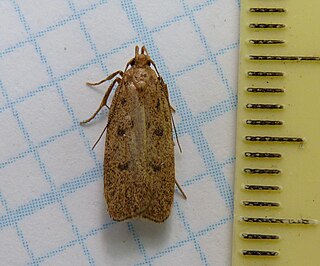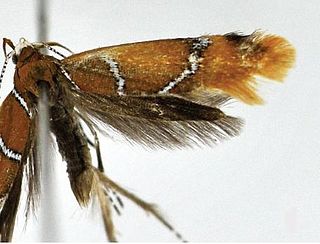
Oecophoridae is a family of small moths in the superfamily Gelechioidea. The phylogeny and systematics of gelechoid moths are still not fully resolved, and the circumscription of the Oecophoridae is strongly affected by this.

Casuarina, also known as she-oak, Australian pine and native pine, is a genus of flowering plants in the family Casuarinaceae, and is native to Australia, the Indian subcontinent, Southeast Asia, islands of the western Pacific Ocean, and eastern Africa.

The Ethmiinae are a subfamily of small moths in the superfamily Gelechioidea sometimes included in the Elachistidae or the Oecophoridae, but mostly in the Depressariidae as a subfamily Ethmiinae.

The Symmocinae are a subfamily of moths in the superfamily Gelechioidea. These small moths are found mainly in the Palearctic and Africa.

The Autostichinae are a subfamily of moths in the superfamily Gelechioidea. Like their relatives therein, their exact relationships are not yet very well resolved. The present lineage was often included in the concealer moth family (Oecophoridae), but alternatively it is united with the Symmocidae sensu stricto to form an expanded family Autostichidae.

Idioglossa is a genus of moths of the family Batrachedridae.

Autosticha is a genus of gelechioid moths. It belongs to the subfamily Autostichinae, which is either placed in the concealer moth family (Oecophoridae), or in an expanded Autostichidae. It is the type genus of its subfamily. Originally, this genus was named Automola, but this name properly refers to a fly genus in family Richardiidae.

Xyloryctidae is a family of moths contained within the superfamily Gelechioidea described by Edward Meyrick in 1890. Most genera are found in the Indo-Australian region. While many of these moths are tiny, some members of the family grow to a wingspan of up to 66 mm, making them giants among the micromoths.

Promalactis is a genus of moths of the family Oecophoridae.
Antipterna assulosa is a species of moth in the family Oecophoridae, first described by Alfred Jefferis Turner in 1940 as Machaeretis assulosa. The species epithet, assulosa, derives from the Latin adjective, assulosus. The holotype for Machaeretis assulosa was collected at Sandgate in Queensland.
Antipterna hemimelas is a species of moth in the family Oecophoridae, first described by Alfred Jefferis Turner in 1940 as Ocystola hemimelas. The species epithet, hemimelas, derives from the Greek, έμιμελας. The male holotype for Ocystola hemimelas was collected in Perth, Western Australia.
Antipterna nivea is a species of moth in the family Oecophoridae, first described by Alfred Jefferis Turner in 1940 as Ocystola nivea. The species epithet, nivea, derives from the Latin adjective, niveus ("snow-white"). The male lectotype for Ocystola nivea was collected at Warwick in Queensland.
Antipterna diplosticta is a species of moth in the family Oecophoridae, first described by Alfred Jefferis Turner in 1944 as Ocystola diplosticta. The species epithet, diplosticta, derives from the Greek, διπλοστικτος. The male holotype for Ocystola diplosticta was collected at Gladstone in Queensland.
Antipterna homopasta is a species of moth in the family Oecophoridae, first described by Alfred Jefferis Turner in 1932 as Periallactis homopasta. The species epithet, homopasta, derives from the Greek, όμοπαστος. The male holotype for Periallactis homopasta was collected at Crows Nest in Queensland.
Antipterna spathulata is a species of moth in the family Oecophoridae, first described by Alfred Jefferis Turner in 1944 as Ocystola spathulata. The species epithet, spathulata, derives from the Latin, spathulatus ("spoon-shaped"). The male lectotype for Ocystola spathulata was collected at Waroona in Western Australia.
Antipterna panarga is a species of moth in the family Oecophoridae, first described by Alfred Jefferis Turner in 1932 as Periallactis panarga. The species epithet, panarga, derives from the Greek, παναργος. The male holotype for Periallactis panarga was collected at Crows Nest in Queensland.
Antipterna naias is a species of moth in the family Oecophoridae, first described by Edward Meyrick in 1902 as Machaeritis naias. The male holotype for Machaeritis naias was collected on Mount Crackenback, New South Wales. The male holotype for Ocystola paralia was collected at Brighton, Victoria.
Antipterna tephrodes is a species of moth in the family Oecophoridae, first described by Oswald Bertram Lower in 1902 as Ocystola tephrodes. The male holotype for Ocystola tephrodes was collected at Stawell in Victoria.
Antipterna microphanes is a species of moth in the family Oecophoridae, first described by Oswald Bertram Lower in 1902 as Ocystola microphanes. The male holotype for Ocystola microphanes was collected at Stawell in Victoria.








